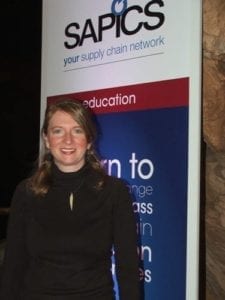With over a thousand delegates in attendance and speakers from around the world presenting a series of workshops and papers, the 35th annual SAPICS conference at Sun City lived up to expectations. Simon Foulds was amongst the delegates.
The theme for this year’s conference and also its call to action was ‘Design for change’. Opening the event, Cobus Rossouw, SAPICS president, said: “This event will inspire you and you will leave better equipped to face the challenges and opportunities in the supply chain world out there. The new SAPICS by-line is ‘your supply chain network’, which encapsulates the purpose of this event and the industry organisation that is hosting it.” “This event is about the profession we are all passionately part of and allows everyone present the opportunity of networking, interacting in order to ensure the industry continues showcasing its achievements. “To be a comprehensive industry association for supply chain professionals, we need deep knowledge in all areas of expertise. We need to build alliances and capabilities to include the fields of transport, distribution, materials handling, procurement and supply management, as well as deeper expertise in the process and systems enablers of supply chain integration – or even value chain integration.” “This is the exciting challenge that faces SAPICS today. The real purpose of an event like the 35th annual SAPICS conference is to give those willing to lead a platform to point the way. To design for change and to share supply chain solution for a dynamic world.” Building better business relationships Kate Vitasek is an author, educator and business consultant as well as an internationally recognised innovator in the practice of supply chain management. At the conference she presented the ‘Vested’ model. “Why do so many business relationships fail to achieve their real potential? One big reason is that they are based on a ‘what’s in it for me’ philosophy. The Vested model of collaboration, shared value principles and trust changes all that. It encourages the parties to act for mutual benefit, to achieve a true win-win, and in the process lay the foundation for sustained success.“Is there a secret sauce for improving your business relationship? That is the question that University of Tennessee (UT) researchers sought to answer with the support of US Air Force funding. UT researchers set out to study some of the world’s most successful business relationships to find if there was knowledge that the Air Force could apply. A key part of the research was to study business relationships based on true collaboration that achieved real results. Not only results, but transformational, game-changing and award-winning results.
“What the researchers found was that these companies had created a radically different type of business relationship: relationships that transcended traditional buy-sell transactions that focus on one party ‘winning’ while the other ‘loses’. They found relationships where the parties worked together towards shared goals to drive innovation, create value and reward success. But while they seemed radical compared to most business relationships today, researchers realised that these companies were actually leveraging Nobel Prize concepts from Nash’s equilibrium theory to Williamson’s Transaction Cost Economics. This new business model was coined ‘Vested’.” The Five Rules of Vested for achieving collaborative, outcome-based partnerships is a unique approach to outsourcing. The five rules are:- adopt an outcome-based versus transaction-based business model
- focus in the what and not the how
- clearly define and measure the desired outcomes
- pricing model with incentives that optimise the business
- governance structure should provide insight, not merely oversight.








